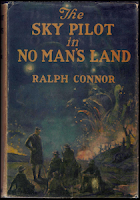Basil King
New York: Harper & Brothers, 1918
54 pages
A short story masquerading as a novella, Abraham's Bosom first appeared in the March 30, 1918 edition of The Saturday Evening Post. Its publication nearly coincided with Germany's devastating spring offensive, which resulted in more than 862,000 Allied dead and wounded.
 |
| Abraham's Bosom frontispiece. |
After receiving his own diagnosis, Noone walks about the city a bit before taking to his death bed. As he lies dying, the reverend reflects upon on his marriage and children. Wife Emily hovers about, propping him up in what she insists are the most comfortable positions. Their five children, whom he considers disappointments, visit from time to time. All are present during his final moments as the reverend gazes somewhat vacantly at an engraving of his favourite painting, William Homan Hunt's The Light of the World. His eyes see the lantern glowing brighter and brighter until it outshines the afternoon sun.
It takes time for Noone to recognize his passing. He'd expected an instant in which his soul would "tear its way out of his body and he should be thrust, a naked, quivering bundle of spiritual nerves, before angels and archangels and principalities and powers, and a God whose first question would be that which was put to Cain: "What hast thou done?"
Instead, he's met by Ned Angel.
As a story, Abraham's Bosom is much shorter than it appears. The diagnosis, wandering, and death bed scenes are brief; the better part of the book involves theological discussion as Angel sets Noone straight on things theosophical and what the reverend may expect now that he has passed through the "great change." It was followed six months later by King's far superior Going West, which concerns a ghostly journey shared by German and American soldiers who have killed each another in battle.
That term – "great change" – features three times in the text, and on the first of three different dust jackets Harper used to sell book (above). I suspect King himself wrote its words. Note the second paragraph:
This story will bring Comfort and Consolation to many who are in trouble of mind about the Hereafter.In the Hereafter, as King believes it to be, those who have passed through this great change see things with different eyes. Berkley Noone sees his wife and children as themselves but themselves glorified:
Emily was again the dryad of their youthful days; but a dryad with ways of light and tenderness he had never known her to possess. Each of the children was bathed in the same beautifying radiance. He knew them – and yet he didn't know them. All he could affirm of them exactly was that his doubts and worryings and disappointments on account of them were past. He felt what Angel had just been telling him, that he was waking from some troubled dream on their behalf.
Knowing the date of composition, some nine months before the Armistice, what struck me most about Abraham's Bosom is its disconnect from the Great War. The conflict, which plays such a part in his novels The High Heart (1917), Going West (1918), The Thread of Flame (1920), The Empty Sack (1921) is not so much as mentioned. Or might it be that the allusion is subtle? Here's Ned Angel:
"How are the Children of Dust making use of the knowledge they've gained during the last fifty years of their counting? Is it to help one another? Is it to benefit themselves? Is it to make the world happier, or more peaceful, or more prosperous? Haven't they taken all their new resources, all their increased facilities, all their approximations to Truth, all their approaches to God – the things which belonged to their peace, as Jesus of Nazareth called them – and made them instruments of mutual destruction? Aren't they straining their ingenuity to devise undreamed-of methods for doing one another harm?''
Object and Access: My copy, which is in pretty rotten shape, was purchased seven years ago as one title in a box containing twenty or thirty old Canadian books. Price: $20.
The frontispiece featuring afflicted organist Ned Angel is one of four Walter H. Everett illustrations commissioned for The Saturday Evening Post. Interestingly, no matter the placing, all depict scenes and from the first third of the story. This image, with caption from the opening pages of the story, appears at on the final page of its Post debut:
The "timid, wild-eyed nymph of a thing who had incarnated for him all that was poetry in the year when he was twenty-eight" is Reverend Noon's wife. She's a cutie!
Online booksellers list copies beginning at five American dollars, but they'll demand a further US$30 or US$35 for shipping. Some have dust jackets, some do not. The one you want to buy is offered by a Massachusetts bookseller who promises an inscribed copy at US$75.
All claim to be offering the first edition, but as I've discovered, there are at least three variants.






















































